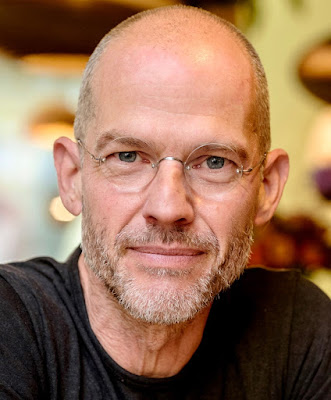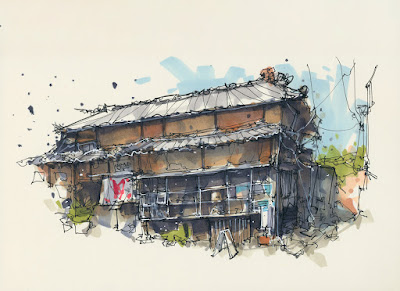I am Albert Kiefer, a self taught digital artist that has decided to return also back to the traditional art of sketching. During the day I make artist impressions and visualizations for clients in the industry and government organizations. These visualizations range from products to historical reconstructions of buildings and complexes.
1. Tell us about your background and journey.
I am a professional digital artist with a background in traditional painting and drawing. My computer work has slowly made me into a perfectionist and for many many years I stopped working traditionally altogether. My perfectionism got in the way of using my traditional drawing skills again so I postponed that decision a very long time.
In the summer of 2016 I finally decided to pick up sketching again. I bought some random sketching materials and laid out some ground rules that would prevent me from prematurely stopping this experiment again. So first I decided to make a new sketch, at least one, every single day. My thinking was that a traditional skill like drawing needs great coordinative skills.
You cannot achieve that by just making a drawing now and then. It has to be practised, like an instrument, many hours per week. Second I wanted these sketches to not take up too much time in my day since I cannot make money while I am sketching or practising (at least not in the short term).
So sketches should not take much longer than an hour. It turned out that my random materials were, for me, a magical fit! I had chosen a Moleskine Artist sketchbook. That specific Moleskine has very sturdy paper that can take a lot of ‘punishment’. And for coloring I used alcohol based color markers. These dry almost immediately so they allow for a very rapid workflow.
2. What inspired you to pursue architecture sketching in particular?
In the beginning of my sketching adventure that was not clear at all… I wanted to make a new sketch every day so that quickly became a problem when I needed to pick a subject to sketch! Since I am a digital artist I sit a lot throughout the day. To compensate for the lack of exercise I take frequent walks all through the day.
And Since some of my sketches of built environments got very positive feedback on social media that was an easy match with my own interest in architecture. I love buildings! SO my daily walks provided great opportunities to either sketch beautiful buildings on location, or take pictures for sketching later in my studio.
3. How would you describe your style and aesthetics?
I would describe it as ‘visual writing’. It is basically an almost continuously flowing movement of my fineliners when I am laying down the linework. I don’t want to go into literal detail because that slows down my pace and then things start to become stiff.
The same goes for the coloring. I lay down the color fast and without much attention to stay within the lines… I want it to be a very loose process. The aesthetics result from that mixed set of intentions.
4. Which mediums do you usually work with?
At the moment I still work with exactly the same materials as when I started in 2016! So that’s color markers from the brands Winsor & Newton, and Copic. For the linework I use Faber-Castell PITT artist fineliners. The sketchbooks are from Moleskine.
5. Who is your favorite artist and why?
There’s not just one favorite artist. I think it’s important to be broader oriented than just limiting yourself to one. But in terms of sketching Thomas Pajdlhauser was one of my first heroes.
I love the way he can make sketches that are very clear and communicative. He still is one of my all time favorites. But I also love the digital concept artists like Mike McCain and of course Craig Mullins and many, many others too
6. What tips and advice would you give to aspiring artists?
First and foremost is that you need to put in the time… I sometimes compare sketching to learning to play an instrument like the guitar. Everyone can buy a guitar, but without very frequent practise you will never get to know the instrument and feel comfortable with it.
That just takes time. Adapt your expectations to that. Accept that not everything you do will be great, or look like the beautiful examples from you heroes. Never forget that most of the incredibly succesful artists put in a massive amount of time and work.
For them, even making only one sketch each day is a joke. They need to make many, many more. So accept and learn from the sketches that you don’t like and make the next one better! Never be discouraged! You really will get better with every new sketch, even the ones you might hate at the moment!
7. Which is your favorite book and why?
I am a book maniac. so asking about just one favorite book is very hard to answer. I have a series of “The Art Of…” books with lots of production sketches on specific movies like Star Wars, many of the PIXAR films and I love browsing through them to see the many design explorations and the different ways in which artists have created their worlds for those movies. So one favorite theme for books would be a better question :-)
















.jpeg)


0 Comments